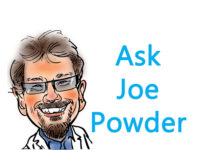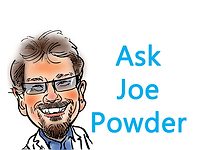Is My Powder Coating Bad or is it a Grounding Issue?

Hi Joe,
We have an automatic spray booth, with eight automatic and two manual (touch-up) guns. When is it best to use manual touch-up, before using automatic powder coat guns or after? Also, we heard that the charging is negative. Why? Would it be better if it was positive? What is the difference?
Regards,
Veselin Kljajevic
Serbia
Hi Veselin,
Thanks for your questions. They’re good ones. One of the challenges with electrostatically applying powder coatings is penetrating tight inside corners and other hard-to-reach areas. The electrostatic field created by the ions generated in a powder gun creates a Faraday Cage that repels the approaching powder particles. This is exacerbated by the insulative effect of powder already deposited on the part.
From my experience, it is much easier to coat the tight inside corners and recesses on a part before applying powder on the easy-to-coat areas. Hence, it is better to manually touch up these tough-to-coat areas before triggering the automatic spray guns.
As for negative versus positive charge, creating negative charge is easier and more efficient than generating positive charge. Negative charge consists of electrons, whereas positive charge relies on protons. Protons are 2,000 times heavier than electrons. In addition, generating electrons is quite easy and controllable using the well-known corona discharge technique.
That said, triboelectric charging technology creates a positively charged powder particle by frictional charging. This involves conveying a powder coating through a specially fabricated spray gun with a PTFE lining that robs the powder particles of their electrons, thus resulting in a net-positive charge on the particle.
The output of these guns is somewhat less than the delivery of a conventional corona discharge gun, but the charging efficiency is greater with fewer free ions generated. This technology was developed in Sweden in the 1980s, and it is still quite commonly used in Scandinavian powder application systems.
I hope that this helps.
Best regards,
Joe
Dear Joe,
I am using a gloss, black polyester-based powder paint in an environment where methylated spirits (denatured alcohol) are present. When the surface comes in contact with the methylated spirits, the gloss hazes over and becomes dull. Similarly, I have a polished steel/nickel-plated part with an alcohol-based liquid lacquer overcoat that suffers the same fate.
I’m looking for the chemistry in a gloss, black powder and a gloss, clear powder that I can substitute for the lacquer that will survive the environment.
Thanks,
Steven Schommer
Illinois
Hi Steve,
Thanks for your question. Methylated spirits will attack some powder coatings but not others. You mention that you’re using a black, high-gloss polyester. Some polyesters are formulated for chemical resistance, whereas others are more for decorative purposes. The one you’re using may be the latter.
Before you change coatings, ensure that the powder is achieving full cure. A less than fully cured powder will be attacked by organic solvents regardless of the chemistry. To check for cure, I recommend leaving the coated part in the cure oven for a longer period of time (say an additional 10 minutes), and then checking the resistance to methylated spirits. If it’s acceptable, then problem solved.
If you see no change in resistance, you should consider switching to a more chemically resistant product. Two chemistries immediately come to mind: polyurethanes and epoxies. Both provide very good to excellent solvent resistance. Epoxies fade in sunlight, so unless this product will never see the (direct) light of day, you should opt for polyurethane chemistry. Polyurethanes are a good choice for a high-gloss finish, as they have relatively low viscosity and provide a glossy surface even at somewhat thin films.
Regarding a clear coat to replace the lacquer, polyurethane is also a good choice. One thing to always keep in mind, however, is to make absolutely sure your coating is completely cured. Otherwise, you cannot expect the film to resist chemical attack, chipping, or scratches.
I hope that this helps.
Best regards,
Joe
Dear Joe,
What is considered world-class, first-pass yield in a powder coat system? Our system consists of two alkaline cleaners, a zirconium conversion coating, and a high-edge, film-build epoxy E-coat, followed by TGIC powder topcoat.
Thanks,
Lee J. Montemayor
Wisconsin
Hi Lee,
First-pass transfer efficiency is affected by several factors. Part geometry and how the parts are presented to the application system have a significant impact on deposition performance. In addition, primers reduce the transfer of charge from the powder to earth. Consequently, some factors require close attention and optimization.
Establishing a rock-solid ground is paramount, as is hanging and spacing parts in an optimal arrangement. Furthermore, manual versus automatic spray will influence transfer efficiency. A good manual sprayer can outperform a so-so automated system.
All that said, I would expect a first-pass transfer efficiency of around 55-65% for a well-designed system spraying three-dimensional parts. It would be much lower for something like wire racks (spraying more air than parts) and somewhat higher for simple two-dimensional parts such as door panels.
In your case, the gun settings should be optimized with lower current to offset the insulative effect of the primer. Your application system supplier can give you more precise settings for their equipment.
I hope this helps. Please let me know if you have any more questions and/or comments.
Best regards,
Joe
Do you have a question for Joe Powder? Email kbiller@chemquest.com. And be sure to listen to the Ask Joe Powder “Powdcast” for all the latest news, insights and technology in the powder coatings industry. Click here to listen!
Looking for a reprint of this article?
From high-res PDFs to custom plaques, order your copy today!





